
a web page by Don Roberson |
ALBATROSSES Diomedeidae |
|||
|
|||
 |
|||
Yellow-nosed Albatross, Indian Ocean taxa (above) |
|||
"I now belong to a higher cult of mortals, Robert Cushman Murphy, writing home from the South Atlantic to his new wife, Grace, in 1912. Every experience with Short-tailed Albatross (right) has left me in awe. The initial experience was with California's first record in many years. Rich Stallcup had seen one at the Cordell Bank on 3 Nov 1985. A chase boat was hurriedly arranged for two days later. It was amongst the roughest trips I've endured, and we were horribly sea-sick. And yet, when the albatross finally appeared, it was like I had paid Neptune's price and achieved the prize of a lifetime. It is now more than 20 years later, but the impact of that first encounter has remained. An albatross — and especially a huge and rare one — leaves a dramatic impression. I've been fortunate to have now seen four in California waters, including one I was the first to spot, but each is a joyous occasion. These shots (above & below) were from a Monterey Bay boat trip in April 2007. |
|||
— Rime of the Ancient Mariner |
|||
|
|||
|
|||
|
|||
Most of the world's albatrosses nest in subantarctic waters in the southern hemisphere. These are great travelers. Huge species such as Shy Albatross (left) and Wandering Albatross (below, a fine shot by Greg Lasley), spend their long lives gliding over the southern oceans. It has been estimated that a 50-year-old albatross has flown something like 3.7 million miles (Safina 2007). |
|||
 |
|||
Albatrosses are long-lived birds with a very slow reproductive strategy. In larger species they do not begin breeding until quite old (even 10-12 years old); the pairs mate for life and often have one chick only every other year; and individual birds can live for over 50 years. |
|||
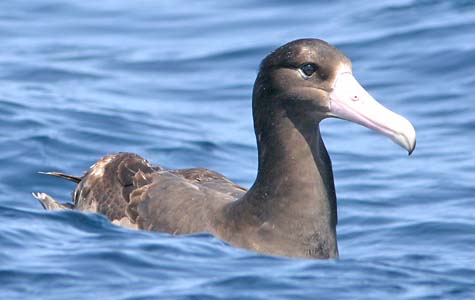 Short-tailed Albatross
(left; a juvenal bird with 'bubble-gum pink' bill) is making a slow
come-back from near extinction. A hundred years ago, it was considered
the easiest albatross to see from shore in Monterey County. Then the
species was almost extirpated by plume hunters on its volcanic nesting
island of Torishima, off Japan. It has been estimated that 5 million
albatross were killed here from 1887-1902, until a volcano in 1902
wiped out the village of the plume hunters. More hunters arrived,
however, and continued to kill thousands of albatrosses a year until
another volcanic eruption in 1939 destroyed the village again. By the
end of World War II, it was estimated that only 30-50 birds were left
(Harrison 1979). Fortunately, the few young birds remaining at sea
until they eventually returned to their natal island. With much
protection and research, the population has rebounded (Carboneras
1992). A recent estimate is perhaps 2000 birds. By the turn of the 21st
century, young Short-tails were occasionally appearing again on
Monterey Bay, and even occasionally again seen from shore! Short-tailed Albatross
(left; a juvenal bird with 'bubble-gum pink' bill) is making a slow
come-back from near extinction. A hundred years ago, it was considered
the easiest albatross to see from shore in Monterey County. Then the
species was almost extirpated by plume hunters on its volcanic nesting
island of Torishima, off Japan. It has been estimated that 5 million
albatross were killed here from 1887-1902, until a volcano in 1902
wiped out the village of the plume hunters. More hunters arrived,
however, and continued to kill thousands of albatrosses a year until
another volcanic eruption in 1939 destroyed the village again. By the
end of World War II, it was estimated that only 30-50 birds were left
(Harrison 1979). Fortunately, the few young birds remaining at sea
until they eventually returned to their natal island. With much
protection and research, the population has rebounded (Carboneras
1992). A recent estimate is perhaps 2000 birds. By the turn of the 21st
century, young Short-tails were occasionally appearing again on
Monterey Bay, and even occasionally again seen from shore! |
|||
While this proposal was not widely accepted by scientists, it was adopted by some conservation organizations. Birdlife International (2000), for example, accepted most of the splits and listed 21 species. These included dividing Wandering into 4 species, Shy into 3 species, and Royal, Black-browed, and Yellow-nosed into two each. Some of these do not appear to be separable at sea, at least in immature plumages. Penhallurick & Wink (2004) collated cytochrome b sequences for almost 90 procellarids, and provided a matrix of genetic distances tied to a molecular clock suggesting when various taxa diverged. They proposed that taxa which differed by less than1.5% should be considered subspecies, not species, and for albatrosses this was just the original 13 species (relumping Amsterdam Albatross). Rheindt & Austin (2005) disputed the Penhallurick & Wink analysis. They found numerous analytical flaws, and pointed out that if one applied the same genetic-distance analysis to ducks, one would lump almost all of the species of Anas together, even those that are undoubted biological species (e.g., Mallard/Pintail and Blue-winged/Cinnamon Teal taxa diverge by only 0.5 to 1.0%). More recently, Milot et al. (2007) showed that the low genetic diversity in albatrosses was a result of their life-style and past genetic roadblocks, rather than a measure of speciation. Meanwhile, Burg & Croxall (2004) reviewed the Wandering Albatross set in detail, and supported species status for four species (nominate exulans Wandering, antipodensis Antipodean, amsterdamensis Amsterdam, and dabbenena Tristan) but relegated the fifth taxa (gibsoni) to a subspecies of Antipodean Albatross. Much of the evidence, though, relied on calibrations of an assumed molecular clock. This type of analysis is fraught with error, both statistical and in the calibration starting points (Graur & Martin 2004). The entire issue is still up for grabs. Dickinson (2003) listed only 13 species, but possibly because the evidence was in such a state of confusion and dispute. The South American Checklist Committee has accepted one split of the basic 13: the separation of white-headed Shy Albatross (Thalassarche cauta/steadi) from the gray-headed taxa in that group (T. [c.] eremita/salvini), primarily because there a few isolated cases of assortative mating in sympatry. and they are now considering whether to adopt a further split between eremita [Chatham Albatross] and salvini [Salvin's Albatross]. It is hard to predict the future on this topic, and more research is needed. Some may tentatively adopt the 21 species of Birdlife International, but I expect it will be revised downward somewhat. Some proposed species, such as Campbell Albatross T. [melanophrys] impavida, or the separation of the two taxa of Royal Albatross D. epomorpha, seem very inclusive so far. |
|||
Some amazing albatrosses have reached California waters, including Shy, Wandering Diomedea exulans, and Light-mantled Albatross Phoebetria palpebrata. |
|||
Photos: The Indian Yellow-nosed Albatross Thalassarche (chlororynchus) carteri, both shots of Shy Albatross Thalassarche cauta, Black-browed Albatross Thalassarche melanophrys, the trawler, and the soon-to-be-released Sooty Albatross Phoebetria fusca were all taken on 4 July 2005 south of Cape Town, South Africa. The Short-tailed Albatross Phoebastria albatrus was photographed on Monterey Bay, California, on 22 Apr 2007. The six Waved Albatross Phoebastria irrorata were just off Española I., Galapagos, on 29 Oct 1989. The landing Black-footed Albatross Phoebastria nigripes was on Monterey Bay on 16 May 1999. The adult Wandering Albatross Diomedea exulans was photographed by Greg Lasley off South Georgia Island on 2 Feb 2000. All photos © Don Roberson, except the Wandering Albatross © Greg Lasley, used with permission; all rights reserved. Bibliographic note:
There are at least two family books on the Albatrosses, but I have not
seen either one as yet. One is a work by Robertson & Gales (1998)
that included the extensive taxonomic revisions discussed above. I am
advised by Angus Wilson that it has a separate chapter of each of the
23 taxa with extensive details on biology and conservation. It appears
to be both well-researched and expensive. The other is a major effort
in Oxford's "Bird Families of the World" series by Brooke & Cox (2004); it covers not only albatrosses but the petrels and shearwaters as well. Literature cited:
|
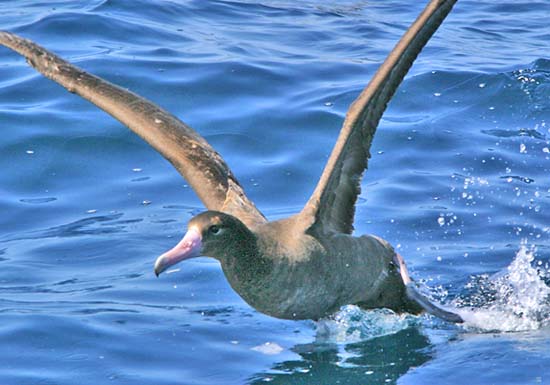
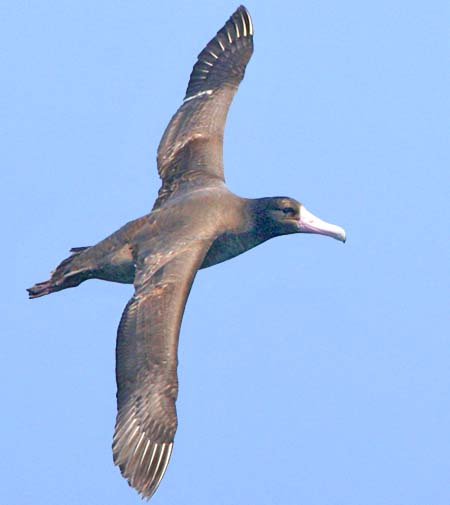 "At length did cross an Albatross:
"At length did cross an Albatross: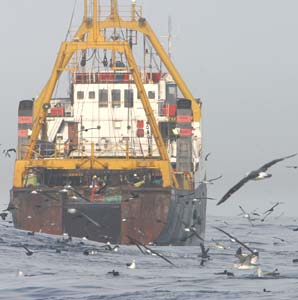


 Albatrosses
roam the sea except when breeding. Then are concentrated in and around
their nesting islands. The only breeding albatross on the equator is Waved Albatross
of the Galapagos. It is a rare bird, nesting only on Española
Island. The photo (above) was taken near that island, at the time we
had in view about 800 albatrosses, perhaps 10% of the world's
population!
Albatrosses
roam the sea except when breeding. Then are concentrated in and around
their nesting islands. The only breeding albatross on the equator is Waved Albatross
of the Galapagos. It is a rare bird, nesting only on Española
Island. The photo (above) was taken near that island, at the time we
had in view about 800 albatrosses, perhaps 10% of the world's
population!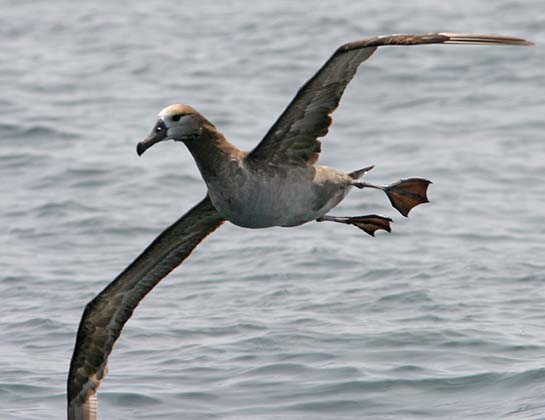 The three north Pacific albatrosses are also great travelers. Radio tagged Black-footed Albatross
(right) have been shown to 'commute' from its breeding grounds on
Midway I., in the middle of the north Pacific, to Monterey Bay to find
food for their young. Laysan Albatross Phoebastria immutabilis
do the same. One can say that a parent albatross may fly more than
10,000 miles to deliver one meal to its chick (Safina 2002, 2007).
The three north Pacific albatrosses are also great travelers. Radio tagged Black-footed Albatross
(right) have been shown to 'commute' from its breeding grounds on
Midway I., in the middle of the north Pacific, to Monterey Bay to find
food for their young. Laysan Albatross Phoebastria immutabilis
do the same. One can say that a parent albatross may fly more than
10,000 miles to deliver one meal to its chick (Safina 2002, 2007). 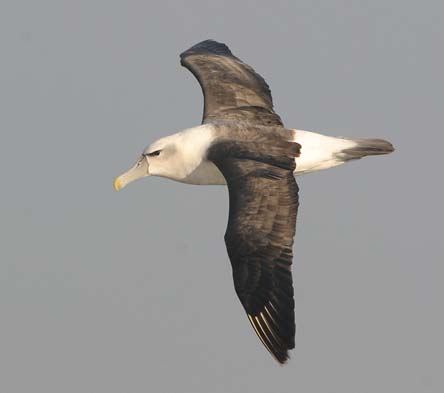 There
are 23 or 24 taxa of albatross, and much controversy about the number
of species. Traditionally there were just 13 species; one more was
added by some in the 1990s (Amsterdam Island Albatross Diomedea amsterdamensis;
e.g., Carboneras 1992). A molecular study in the mid-1990s (Nunn et al.
1996) found four major clades, and they resurrected old generic names
for the four groups: Phoebastria for the equatorial and north Pacific species, Thalassarche for the mollymawks (such as Black-browed Albatross, right), restricted Diomedea to the giant albatrosses, and retained Phoebetria
for the two sooty albatrosses. Using much of the same genetic evidence,
and relying on a phylogenetic species concept, Robertson & Nunn
(1998) then raised 23 taxa to species level, arguing in part that
splitting them would draw attention to the conservation needs of many
of them.
There
are 23 or 24 taxa of albatross, and much controversy about the number
of species. Traditionally there were just 13 species; one more was
added by some in the 1990s (Amsterdam Island Albatross Diomedea amsterdamensis;
e.g., Carboneras 1992). A molecular study in the mid-1990s (Nunn et al.
1996) found four major clades, and they resurrected old generic names
for the four groups: Phoebastria for the equatorial and north Pacific species, Thalassarche for the mollymawks (such as Black-browed Albatross, right), restricted Diomedea to the giant albatrosses, and retained Phoebetria
for the two sooty albatrosses. Using much of the same genetic evidence,
and relying on a phylogenetic species concept, Robertson & Nunn
(1998) then raised 23 taxa to species level, arguing in part that
splitting them would draw attention to the conservation needs of many
of them.